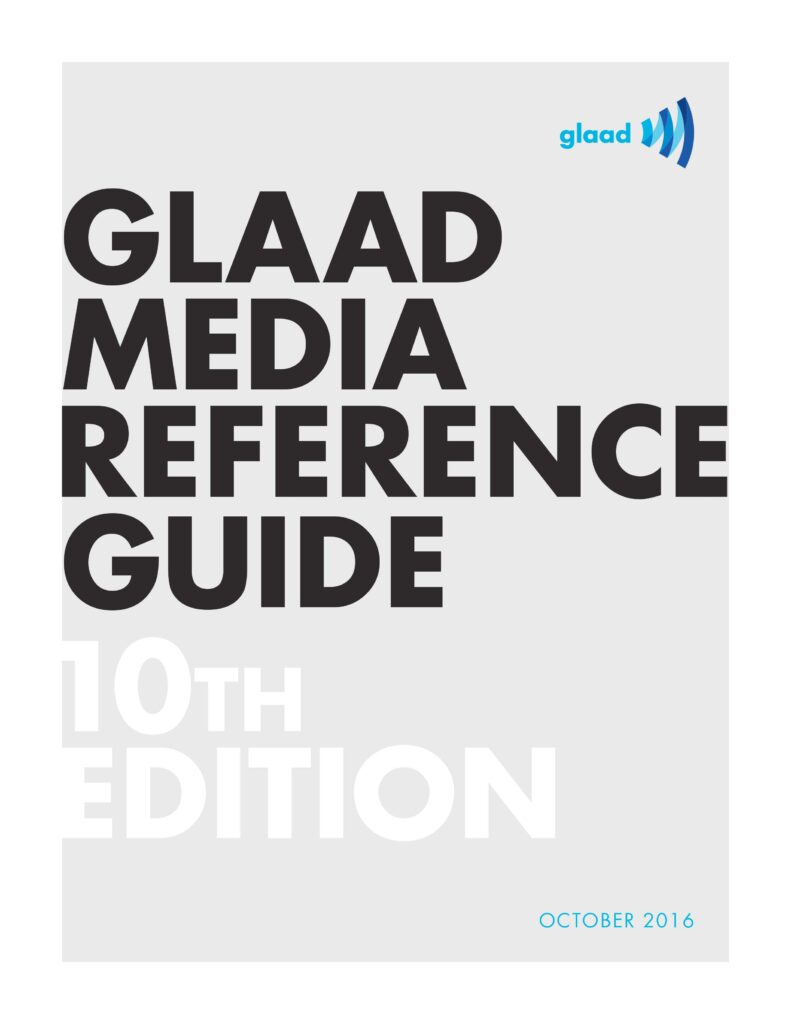With growing media covering of trans* issues, it is paramount to educate journalists and professionals on how to write correctly about a community with a long history of discriminative representation.
The following definitions and instructions are provided by GLAAD, an association founded by journalists and writers in 1985, in response to the New York Post’s defamatory and sensationalized HIV and AIDS coverage. In 1987, GLAAD persuaded The New York Times to change its editorial policy and begin using the word gay. Since then, the association has worked to improve the media depiction of the LGBTQIA+ community, providing honest representation and campaigning against discrimination and censorship. For example, every year since 1996, GLAAD has released a report called Where we are on TV, tracking the number of LGBTQIA+ characters on television and the roles they play. Furthermore, it has provided guidelines for all journalists dealing with trans* people.
General guidelines
- Always use a trans* person’s chosen name. The name they were assigned at birth is often referred to as “deadname”, so the practice of calling them by the wrong name is known as “deadnaming”.
- Use the pronoun that matches the person’s authentic gender. If you are not certain which pronoun to use, ask the person, “What pronouns do you use?”.
- Avoid the following terms: “a transgender” (always use it as an adjective and never as a noun), “transgendered” (you wouldn’t say “gayed” or “lesbianed”), “sex change / pre-op / post-op” (use “transition” instead), “biologically / genetically / originally man or woman” (if you absolutely have to, then write “assigned / designated male or female at birth”).
- Move beyond the “coming out” narrative: just as coverage of the LGB community now focuses on many different aspects of being gay, lesbian, or bisexual, the media is encouraged to look for stories about trans* people that go beyond “when did you know” and “what surgeries have you had”.
- Avoid focusing on medical issues. It is inappropriate to ask a trans* person questions about their genitals or other surgeries they may or may not have had.
- Be aware of the differences between trans women, cross-dressers, and drag queens. Use the term preferred by the person. Do not use the word “transvestite” at all, unless someone specifically self-identifies that way.
GLAAD also helps to explain the meaning of crucial terms:
Transgender (adj.)
An umbrella term for people whose gender identity differs from the sex they were assigned at birth. People under the transgender umbrella may describe themselves using one or more of a wide variety of terms. Use the descriptive term preferred by the person. Many transgender people are prescribed hormones by their doctors to bring their bodies into alignment with their gender identity. Some undergo surgery as well. But not all transgender people can or will take those steps, and a transgender identity is not dependent upon physical appearance or medical procedures.
Transsexual (adj.)
An older term that originated in the medical and psychological communities. Still preferred by some people who have permanently changed – or seek to change – their bodies through medical interventions, including but not limited to hormones and/or surgeries. Unlike transgender, transsexual is not an umbrella term. Many transgender people do not identify as transsexual and prefer the word transgender. It is best to ask which term a person prefers. If preferred, use as an adjective: transsexual woman or transsexual man.
Trans
Used as shorthand to mean transgender or transsexual – or sometimes to be inclusive of a wide variety of identities under the transgender umbrella. Because its meaning is not precise or widely understood, be careful when using it with audiences who may not understand what it means. Avoid unless used in a direct quote or in cases where you can clearly explain the term’s meaning in the context of your story. Trans* is currently considered by some the most including version of the term, as “it expands the boundaries of the category to be radically inclusive” and “can be understood as the most inclusive umbrella term to describe various communities and individuals with nonconforming gender identities and/or expressions” (Nash, Q Center); however, its use is not encouraged by all, and some find it offensive.
Transition
Altering one’s birth sex is not a one-step procedure; it is a complex process that occurs over a long period of time. Transition can include some or all of the following personal, medical, and legal steps: telling one’s family, friends, and co-workers; using a different name and new pronouns; dressing differently; changing one’s name and/or sex on legal documents; hormone therapy; and possibly (though not always) one or more types of surgery. The exact steps involved in transition vary from person to person. Avoid the phrase “sex change”.
Sex Reassignment Surgery (SRS)
Also called Gender Confirmation Surgery (GCS). Refers to doctor-supervised surgical interventions, and is only one small part of transition. Avoid the phrase “sex change operation”. Do not refer to someone as being “pre-op” or “post-op”. Not all transgender people choose to, or can afford to, undergo medical surgeries. Journalists should avoid overemphasizing the role of surgeries in the transition process.


Implementing gender diversity interventions effectively (Sweden)

Everything is very open with a precise clarification of the challenges. It was really informative. Your website is useful. Thanks for sharing!